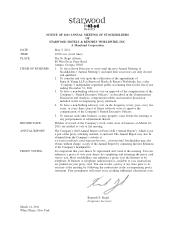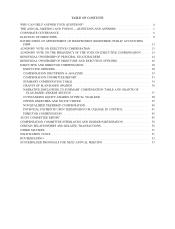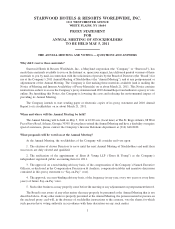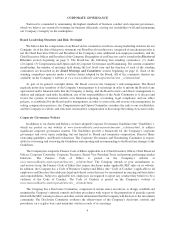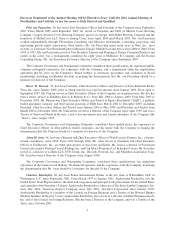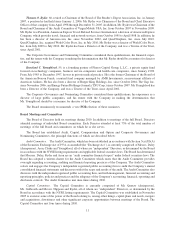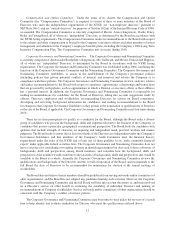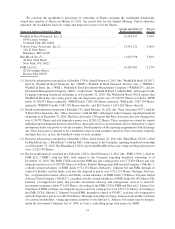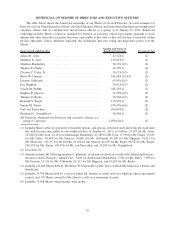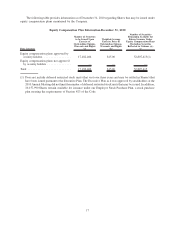Starwood 2010 Annual Report Download - page 19
Download and view the complete annual report
Please find page 19 of the 2010 Starwood annual report below. You can navigate through the pages in the report by either clicking on the pages listed below, or by using the keyword search tool below to find specific information within the annual report.The Board has a policy under which Directors who are not employees of the Company or any of its subsidiaries
may not stand for re-election after reaching the age of 72. In addition, under this policy, Directors who are
employees of the Company must retire from the Board upon their retirement from the Company. Pursuant to the
Guidelines, the Board also has a policy that Directors who change their principal occupation (including through
retirement) should voluntarily tender their resignation to the Board.
The Company encourages all Directors to attend the Annual Meeting and believes that attendance at the
Annual Meeting is as important as attendance at meetings of the Board of Directors and its committees. In fact, the
Company typically schedules Board of Directors’ and committee meetings to coincide with the dates of its Annual
Meetings. However, from time to time, other commitments prevent all Directors from attending a meeting. All but
one of the Directors who were Board members at the time attended the most recent annual meeting of stockholders,
which was held on May 13, 2010.
The Company indemnifies its Directors and officers to the fullest extent permitted by law so that they will be
free from undue concern about personal liability in connection with their service to the Company. This is required
under the Company’s charter, and the Company has also signed agreements with each of those individuals
contractually obligating it to provide this indemnification to them.
Director Independence
In accordance with New York Stock Exchange (the “NYSE”) rules, the Board makes an annual determination
as to the independence of the Directors and nominees for election as a Director. No Director will be deemed to be
independent unless the Board affirmatively determines that the Director has no material relationship with the
Company, directly or as an officer, stockholder or partner of an organization that has a relationship with the
Company. The Board observes all criteria for independence established by the NYSE listing standards and other
governing laws and regulations. In its annual review of Director independence, the Board considers any com-
mercial, banking, consulting, legal, accounting, charitable or other business relationships each Director may have
with the Company. In addition, the Board consults with the Company’s counsel to ensure that the Board’s
determinations are consistent with all relevant securities and other laws and regulations regarding the definition of
“independent director,” including but not limited to those set forth in pertinent listing standards of the NYSE in
effect from time to time. As a result of its annual review, the Board has determined that all of the Directors, with the
exception of Mr. van Paasschen, are independent directors. Mr. van Paasschen is not independent because he is
serving as the Chief Executive Officer and President of the Company.
In making this determination, the Board took into account that three of the non-employee Directors,
Messrs. Aron and Daley and Ms. Galbreath, have no relationship with the Company except as a Director and
stockholder of the Company and that the remaining seven non-employee Directors have relationships with
companies that do business with the Company that are consistent with the NYSE independence standards. With
respect to Mr. Duncan, the Board considered the fact that Mr. Duncan served as the Company’s Chief Executive
Officer on an interim basis from April 1, 2007 to September 24, 2007, and received a salary and other benefits for his
services. As that service was more than three years ago, the Board determined that Mr. Duncan is an independent
director.
Yahoo! Inc., Buddy Media, The Huffington Post, Amazon.com, Inc., Burger King Holdings, Inc., The Gap,
Inc., American Express Company and Intel Corporation are the only companies to transact business with the
Company over the past three years in which any of the Company’s independent directors served as a director,
executive officer or is a partner, principal or greater than 10% stockholder. Mr. Hippeau is a director of Yahoo! Inc.
and Buddy Media and the Chief Executive Officer of The Huffington Post; Mr. Ryder is a director of Amazon.com,
Inc.; Mr. Youngblood is a director of Burger King Holdings, Inc. and The Gap, Inc.; and Ambassador Barshefsky is
a director of American Express Company and Intel Corporation. In the case of each public company other than
American Express Company, the combined annual payments from the Company to each such entity and from each
such entity to the Company has been less than 0.5% of the Company’s and/or each such other entity’s annual
consolidated revenues for each of the past three years. In the case of American Express Company, with which the
Company co-brands the American Express Starwood Preferred Guest credit card, the combined annual payments
from the Company to American Express Company and from American Express Company to the Company has been
7


